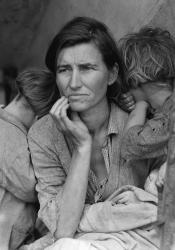The role of Perception in Photojournalism
Photojournalism is one of the best techniques used to tell stories. While it's been around since the 1850s and was mostly used during wars amongst countries, whenever I think of images that tell a story, the image of Florence Owens Thompson by Dorethea Lange instantly comes to mind. This image tells the story of the hardships faced by many citizens during the great depression. The emotions that the image evoked were felt by just about anyone that saw it and Thompson was later dubbed "The face of the great depression". This brings me to question what is it about Photojournalism that makes it so impactful? To further expand, what does the common way in which we perceive images in media say about us as humans?
When it comes to images, the human eye tends to wander all over the picture. This is the process we all go through to try and understand exactly what it is we’re seeing. Photojournalists tell stories with their images so It’s normal to search for some understanding in the pictures. Humans pick up on cues such as facial expressions, body language, and even the angle of the image to decipher their meaning. This is also a normal part of the process. The way in we which perceive images in media is something many researchers are trying to gain a more concrete understanding to this day. Although peculiar what It comes down to is the framing of the image. Framing is how media outlets shape mass opinion. Agenda-Setting is similar but deals with repeated exposure to messages. Journalists use both of these techniques to their benefit when telling their stories.
We’ve all been subject to these techniques even realizing it. Unless you have an understanding of social science and the way the media works, Agenda-Setting, and Framing can be hard to detect. The results show from the use of both techniques leads me to believe that humans are more easily influenced than one may think. Photojournalism uses these techniques and has shaped how people see many issues. Ranging from social issues to fashion. Thanks to the camera, journalists have the ability to push for social change and influence society all through their images.
This image I chose is called "Migrant Mother" by Dorothea Lange. This photo is one of many in a series and is one of the best examples of modern photojournalism. It was taken in March of 1936 in Nipomo California during the great depression. Aside from what the Image makes us feel, the Story behind the image is about a mother of 7 that was living in a tent on a camp for Migrant farmworkers. This image was not only a powerful tool to show the world the conditions in America but for journalists today, it shows the real power of Photojournalism. With the arms of her kids wrapped around her, we see a mother who appears to be disheveled with a worried look on her face. Just by looking at the image, it is no doubt that we as people instantly feel concerned and want to know the context of the image. The candid and authentic aesthetic of the image is what makes it so powerful. The subject of the image is a real person with a real and relatable story.
The impact of this image can still be seen today. Many other powerful images are taken by photojournalists still follow this same aesthetic of authenticness today. Many even still shoot images in black and white because of the way we as an audience perceive it. Along with its timeless element, Images of black and white emphasize emotion and subtly forces viewers to pay attention to details as a society, images like this have shaped the way we perceive America's history. There may have been thousands of other stories like this during the time, but impactful images like "migrant mother" visually put things into perspective when discussing historic events.
Sources
Rosenblum, Naomi. A World History of Photography. Abbeville Press Publishers. 1997. 695 pages.
Collins, Ross. “A Brief History of Photography and Photojournalism.” History of Photography and Photojournalism., 2019, www.ndsu.edu/pubweb/~rcollins/242photojournalism/historyofphotography.html.
Lange, Dorothea. Migrant Mother. New York City, www.moma.org/learn/moma_learning/dorothea-lange-migrant-mother-nipomo-ca.... Accessed 7 Oct. 2020.

